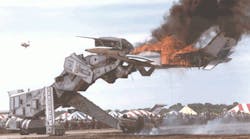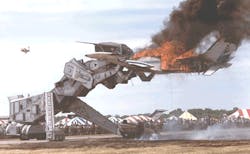In day-to-day operations of hydraulic equipment, you get the reliability you invest in. If, as an owner or operator, you tolerate unreliable hydraulic equipment and the operating conditions or design deficiencies that cause it, then you’ll only get more of the same. That’s why proper maintenance is key to keeping hydraulic systems running smoothly.
Remember, hydraulic machines are supposed to be an asset to your business — not a two-headed beast with an insatiable appetite for oil, filters, hoses, seals, pumps, motors, cylinders, and valves. Such a beast brings equipment to a halt all too often, and at the most inconvenient times. The beast demands to be fed an expensive cocktail of parts and labor — while production schedules go down the drain and employees play cards in the lunch room on full pay.
If you currently are responsible for a hydraulic machine that is more of a liability than an asset, the solution is pretty obvious. You have to kill the beast — once and for all. But what may not be so clear to you is how to go about it. Or even where to start.
The first step in breaking this vicious cycle is being aware of what can be achieved. Beyond a heightened awareness of what’s possible, the following three things are the foundation for reliability of every hydraulic machine.
Keep your cool
First, you must define a hydraulic machine’s temperature operating window (TOW) because that is essential for maximum reliability and minimum downtime. It doesn’t matter what else you do, if you allow your machine to operate outside its TOW, it’ll give you ongoing problems.
However, in my experience, most hydraulics people never bother to determine a machine’s TOW. Some get away with not doing it, others are not so lucky. But it’s just too important to leave to chance. Knowing your machine’s TOW—and keeping it operating within that window — is vitally important for your hydraulic system reliability.
The temperature operating window is most often determined by the viscosity of the hydraulic oil. Thus, it defines the maximum and minimum oil temperatures within which the hydraulic system can safely operate.
According to data from Exxon Mobil Industrial, a hydraulic fluid’s TOW depends, in large part, on its initial viscosity. In addition, shear stability can also impact TOW. For example, says Mobil, a shear stable fluid has a broader TOW than a less shear stable fluid of higher VI. Increasing shear reduces the high temperature properties of the fluid by lowering the viscosity.
You must regularly check that a machine’s actualtemperature operating window lies within the allowabletemperature operating window and, ideally, within the optimum temperature operating window for the oil. If the machine operates at temperatures outside these numbers, something has to change. And it likely will be the oil.
As I’ve written in the past about high-temperature systems (The next advance in hydraulics: Progress or regress? from May 2012),for every 10°C increase in temperature, the rate of reaction doubles. These reactions include oxidation, due to the presence of air; and hydrolysis, due to the presence of water. The hotter the oil, the faster the rate of these reactions — and exponentially so. When it comes down to it, increasing hydraulic system temperature does not enhance performance; it only hinders it in the long run.
A balancing act
Next, you must be aware that every hydraulic system has a “native” efficiency based on how it’s designed and the components used in its construction. The extent to which a hydraulic machine is inefficient in converting input power into useful work determines the heat load it produces, as shown in the table.
This heat load must be offset to achieve thermal balance — but not just thermal balance at some arbitrary temperature. Thermal balance must fall within a machine’s TOW. If thermal balance occurs outside a machine’s safe TOW, the result will be a heat-damaged hydraulic system. And a heat-damaged hydraulic machine is an unreliable one.
Keep it clean
Finally, maintaining appropriate oil cleanliness targets is also essential for hydraulic system reliability and longevity. But this is not a one-size-fits-all type of decision. Many things need to be considered when setting targets for particulate and water concentration in the oil. These include operating pressure, the type of system, the design of the components used, and the criticality of the machine itself.
Controlling particle contamination in your hydraulic oil is critical. And temperature and contamination often work hand-in-hand when causing oil to fail. For example, sludge buildup on hydraulic filter media and varnish are by-products of the oil oxidation process. And oxidation debris and wear particles from a hydraulic machine are most often caused by extremely high temperatures.
From clunker to lean
According to industry sources, up to 90% of these costly, premature failures can be avoided. Transforming your hydraulic beast into a reliable and lean hydraulic machine will almost always involve properly executing these three steps and even more. But the good news is that if you get these three things right, you can be in that 10% that hopefully prevents most of these failures.
Brendan Casey is the founder of HydraulicSupermarket.com and an author of several hydraulic maintenance and troubleshooting books. A hydraulics specialist with an MBA, he has more than 20 years experience in the design, maintenance and repair of mobile and industrial hydraulic equipment. Visit his website at www.hydraulicsupermarket.com for more details.
Read more MRO articles about preventive maintenance; controlling pressure and temperatures; selecting the right fluids; and more by visiting Brendan Casey’s author page.



